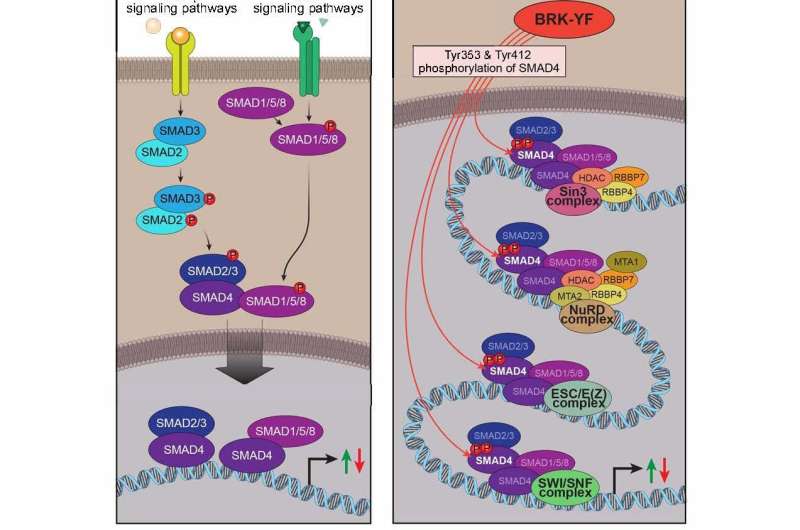Zeroing in on how a tumor suppressor protein is cast away

Researchers from the Stowers Institute for Medical Research have uncovered new details about several proteins implicated in tumor growth and metastasis, opening a potential avenue for the development of treatments for diseases such as breast cancer.
The research focuses on the tumor-suppressing function of SMAD4, a transcription factor protein normally involved in the regulation of cell growth processes. Its function is often turned off in breast cancer, which allows tumors to grow and metastasize. In this report, published online October 23, 2019, in Science Advances, the researchers found that BRK, a non-receptor protein tyrosine kinase, binds to and leads to SMAD4 breakdown. The study was done using human cell lines, including a panel of breast cancer cell lines.
"The BRK kinase is present in more than 85 percent of breast cancer tumors," said Sayem Miah, Ph.D., a postdoctoral research associate in the laboratory of Michael Washburn, Ph.D., at the Stowers Institute. "Our research suggests that treatments targeting BRK may help keep SMAD4 function intact, therefore reducing or stopping tumor growth," Miah says.
Miah began this research while he was a Ph.D. student at the University of Saskatchewan, Saskatoon, Canada, working with Kiven Erique Lukong, Ph.D., whose lab studies BRK. "We've known for a while that BRK functions like an oncogene—a gene that has the potential to cause cancer when mutated or abnormally expressed—in breast cancer," Miah explains. "Ultimately, we want to know whether BRK alone can drive breast cancer progression, and if so, by what mechanism."
After he completed his Ph.D. work at the University of Saskatchewan, Miah moved to Stowers where he joined the Washburn Lab, which focuses on using proteomic approaches to understand biological processes.
"It's a good example of the type of research that's possible at Stowers," Washburn says. "We have the resources, freedom, and flexibility to allow scientists like Dr. Miah to follow up on intriguing results and finish research projects that produce results like this." Washburn also notes that Miah was able to use a powerful mass spectrometer at Stowers to complete his research. "There's value in this kind of serendipity in science. Dr. Miah brings a totally different set of skills and insights to our group, and our lab offers new access to technology and expertise."
Miah believes that these findings are an important step in understanding how cancer works and would like to find other molecules that work with BRK to degrade SMAD4. "If we can further increase our understanding of this protein network, these insights may reveal new targets for metastatic cancer intervention," he said.
Other contributors to the research include Charles A.S. Banks, Ph.D., Anita Saraf, Ph.D., Gaye Hattem, Cassandra G. Kempf, Mihaela Sardiu, Ph.D., and Laurence Florens, Ph.D., from the Stowers Institute, and Yetunde Ogunbolude, Ph.D., Edward T. Bagu, Ph.D., Josh MacAusland-Berg, and Scott Napper, Ph.D., from the University of Saskatchewan.
More information: "BRK phosphorylates SMAD4 for proteasomal degradation and inhibits tumor suppressor FRK to control SNAIL, SLUG, and metastatic potential" Science Advances (2019). advances.sciencemag.org/content/5/10/eaaw3113




















